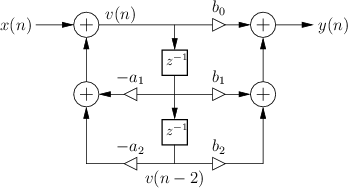
This site uses cookies to deliver our services and to show you relevant ads and job listings. By using our site, you acknowledge that you have read and understand our Cookie Policy, Privacy Policy, and our Terms of Service. Your use of the Related Sites, including DSPRelated.com, FPGARelated.com, EmbeddedRelated.com and Electronics-Related.com, is subject to these policies and terms.
The signal flow graph for the Direct-Form-II (DF-II) realization of the second-order IIR filter section is shown in Fig.9.2.
 |
The difference equation for the second-order DF-II structure can be written as


Since the poles come first in the DF-II realization of an IIR filter, the signal entering the state delay-line (see Fig.9.2) typically requires a larger dynamic range than the output signal . In other words, it is common for the feedback portion of a DF-II IIR filter to provide a large signal boost which is then compensated by attenuation in the feedforward portion (the zeros). As a result, if the input dynamic range is to remain unrestricted, the two delay elements may need to be implemented with high-order guard bits to accommodate an extended dynamic range. If the number of bits in the delay elements is doubled (which still does not guarantee impossibility of internal overflow), the benefit of halving the number of delays relative to the DF-I structure is approximately canceled. In other words, the DF-II structure, which is canonical with respect to delay, may require just as much or more memory as the DF-I structure, even though the DF-I uses twice as many addressable delay elements for the filter state memory.
This site uses cookies to deliver our services and to show you relevant ads and job listings. By using our site, you acknowledge that you have read and understand our Cookie Policy, Privacy Policy, and our Terms of Service. Your use of the Related Sites, including DSPRelated.com, FPGARelated.com, EmbeddedRelated.com and Electronics-Related.com, is subject to these policies and terms.

This book is a gentle introduction to digital filters, including mathematical theory, illustrative examples, some audio applications, and useful software starting points.